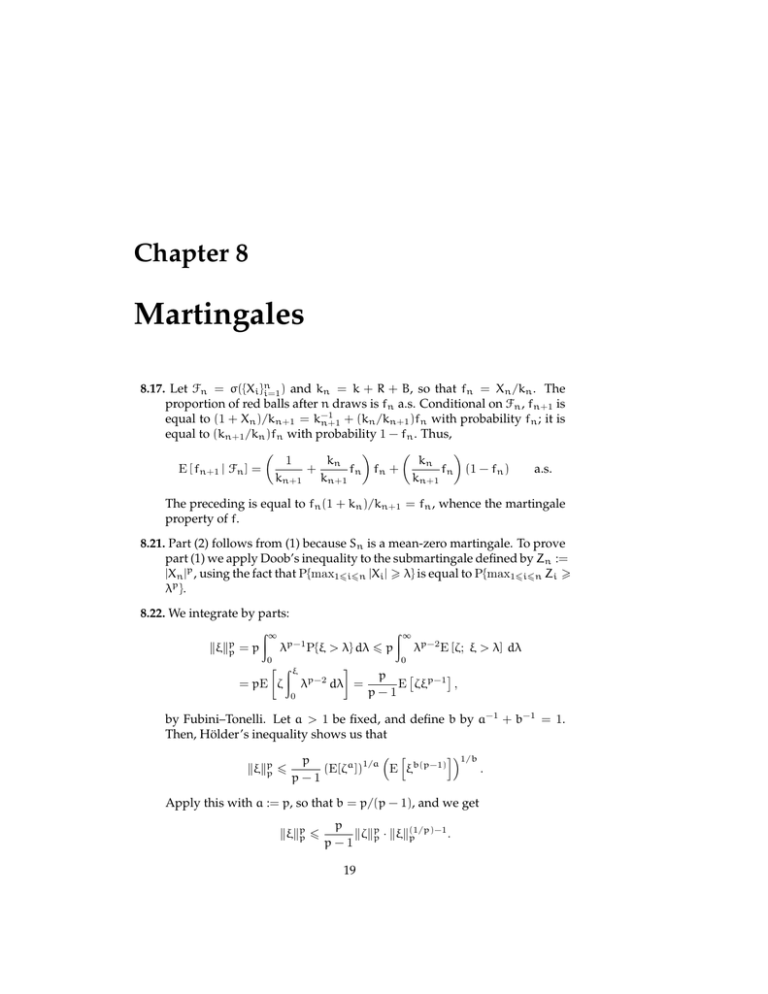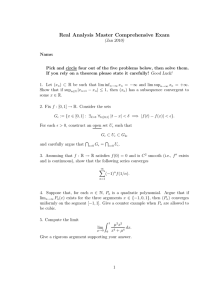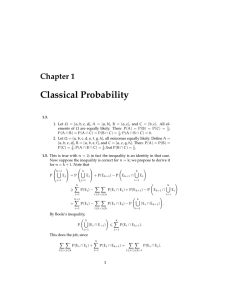Martingales Chapter 8
advertisement

Chapter 8
Martingales
8.17. Let Fn = ({Xi }n
i=1 ) and kn = k + R + B, so that fn = Xn /kn . The
proportion of red balls after n draws is fn a.s. Conditional on Fn , fn+1 is
equal to (1 + Xn )/kn+1 = k-1
n+1 + (kn /kn+1 )fn with probability fn ; it is
equal to (kn+1 /kn )fn with probability 1 - fn . Thus,
✓
◆
✓
◆
1
kn
kn
E [ fn+1 | Fn ] =
+
fn fn +
fn (1 - fn )
a.s.
kn+1 kn+1
kn+1
The preceding is equal to fn (1 + kn )/kn+1 = fn , whence the martingale
property of f.
8.21. Part (2) follows from (1) because Sn is a mean-zero martingale. To prove
part (1) we apply Doob’s inequality to the submartingale defined by Zn :=
|Xn |p , using the fact that P{max16i6n |Xi | > } is equal to P{max16i6n Zi >
p
}.
8.22. We integrate by parts:
Z1
Z1
p-1
p-2
k⇠kp
=
p
P{⇠
>
}
d
6
p
E [⇣; ⇠ > ] d
p
0
0
Z⇠
⇥
⇤
p
p-2
= pE ⇣
E ⇣⇠p-1 ,
d =
p
1
0
by Fubini–Tonelli. Let a > 1 be fixed, and define b by a-1 + b-1 = 1.
Then, Hölder’s inequality shows us that
k⇠kp
p 6
⇣ h
i⌘1/b
p
(E[⇣a ])1/a E ⇠b(p-1)
.
p-1
Apply this with a := p, so that b = p/(p - 1), and we get
k⇠kp
p 6
p
(1/p)-1
k⇣kp
.
p · k⇠kp
p-1
19
20
CHAPTER 8. MARTINGALES
If k⇠kp = 0 then there is nothing to prove. Else, k⇠kp > 0, and we can
divide the preceding by k⇠kp and solve to finish the first portion.
Apply the said result with ⇠ := max16i6n Xi and ⇣ := Xn to obtain
Doob’s maximal inequality (8.70). Finally, apply this to the proof of Theorem 8.20 to finish.
8.27. It suffices to prove that whenever Z is measurable with respect to (X)
we can find a Borel function f : R ! R such that Z = f(X). Recall that
(X) = X-1 (A) : A 2 B(R) .
Now let us first consider the case that Z is a (X)-measurable elementary
function; that is, Z = c1E for some E 2 (X) and c 2 R. Because E =
X-1 (A) for some Borel set A, it follows that Z(!) = c1A (X(!)). This
proves readily that if Z a (X)-measurable simple function then Z = f(X)
for some Borel function f.
If Z is a (X)-measurable, bounded function, then we can find (X)measurable elementary functions {Zn }1
n=1 such that limn!1 Zn (!) =
Z(!) for all ! 2 ⌦. Since Zn = fn (X) for some Borel function fn , we
find that
Z(!) = lim fn (X(!)).
n!1
We don’t know that limn!1 fn exists. It it did then f = limn fn satisfies
Z = f(X). To remedy this, let us define
f(x) := lim sup fn (x)
n!1
for all x 2 R.
Clearly, f is Borel measurable and Z(!) = f(X(!)) for all !! This does
the job in the case that Z is bounded and (X)-measurable.
Finally consider the general case where Z is a (X)-measurable random
variable. By considering Z± we may assume without loss of generality
that Z(!) > 0 for all ! 2 ⌦. In this case, define Z(n) (!) := min{Z(!) , n}.
Since Z(n) is bounded and (X)-measurable it follows that Z(n) = gn (X)
for a non-negative Borel function gn . Let g := lim supn!1 gn in order to
see that g is a nonnegative Borel function and Z = g(X). The does the job.
8.28. Let T := inf{j > 1 : |Sj | > } where inf ? := 1. Since Mn := S2n - nVarX1
defines a mean-zero martingale, the optional stopping theorem implies
that
ES2n^T = VarX1 E(T ^ n).
Because |ST ^n | 6 B + , we have
( + B)2 > nVarX1 P{T > n} = Var(Sn )P{ max |Sj | 6 }.
16j6n
8.29. If Xn is bounded in Lp (P), then supn |Xn | 2 Lp (P), thanks to Doob’s maximal inequality. Use the dominated convergence theorem in conjunction
with the martingale convergence theorem to finish.
21
8.30. Note that
Xn = 2n-1
n
Y
j.
j=1
Therefore, |Xn | 6 2n-1 , whence Xn 2 L1 (P); also Xn is Fn := (
measurable, and
E(Xn+1 | Fn ) = 2n-1 ·
n-1
Y
j=1
j · E(
n-2
n) = 2
n-1
Y
j
= Xn
1
,...,
n )-
a.s.
j=1
Therefore, X is a martingale. It is also L1 (P)-bounded: Because X is nonnegative, supn E(|Xn |) = supn E(Xn ) = E(X1 ) = 1. We know from the
martingale convergence theorem that limn!1 Xn exists and is finite a.s.
In fact, that limit is zero: Indeed, by the Borel–Cantelli lemma n = 0 for
infinitely-many values of n. It suffices to prove that Xn does not converge
to zero in L1 (P). But that follows from kXn - 0k1 = E(Xn ) = 1.
8.36. We will need the following variant of the optional stopping theorem.
Theorem: Suppose {Xn }1
n=1 is a non-negative super martingale with respect to
a filtration F := {Fn }1
n=1 , and T is an F-stopping time. Then,
E [ Xn | FT ] 6 XT
a.s. on {T < n}.
Proof: Let d0 := 0 andPF0 := {? , ⌦}, then define dn+1 := Xn+1 - Xn for
all n > 0. Then, Xn = n
j=1 dj , and E[dj+1 | Fj ] 6 0. Almost surely,
Xn 1{T <n} = XT 1{T <n} +
n
X
dj 1{T <j}
j=1
Therefore, for all A 2 FT ,
n
⇥
⇤
⇥
⇤ X
E Xn 1{T <n} ; A = E XT 1{T <n} ; A +
E [dj ; A \ {T < j}]
⇥
⇤
j=1
6 E XT 1{T <n} ; A ,
because A \ {T < j} 2 Fj-1 . This proves the theorem.
⇤
Now we return to the problem at hand. By the martingale convergence
theorem X1 := limn!1 Xn exists and is finite a.s. Let T := inf{n > 1 :
Xn = 0}, and note that we we are told that T is finite a.s. Apply Fatou’s
lemma to find that
EX1 6 lim inf E [Xn ; T < n] = lim inf E [E ( Xn | FT ) ; T < n] .
n!1
n!1
By the stated theorem, this is at most lim inf n E[XT ; T < n] 6 EXT = 0.
Since X1 > 0 a.s., X1 must be zero a.s. In fact, a small modification of
this proof shows that with probability one, XT +n = 0 for all n > 1.




